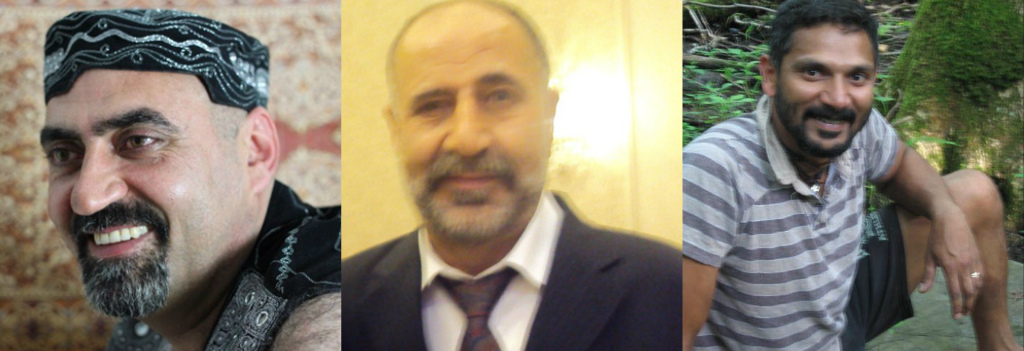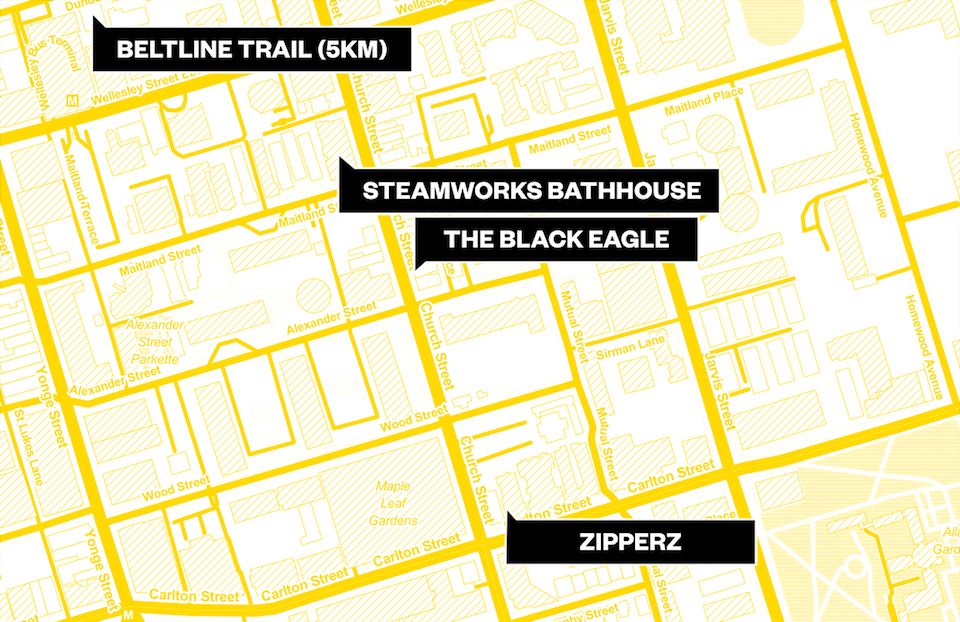Skandaraj Navaratnam stepped out of Zipperz at closing time, with a man on his arm.The pair stumbled onto Carlton Street, a nondescript drag of diners, drug stores, and dry cleaners on the fringes of Toronto’s gay village, just around the corner from the flashy rainbow flag-laden bars of Church Street. It was a chilly Monday morning, but since it was Labour Day, there was no reason not to celebrate.September 6, 2010 was the last time anyone recalls seeing Navaratnam in public.Abdulbasir Faizi emerged into an alleyway just three blocks north, four months later. It was four days after Christmas, and just below freezing. He told his wife that he would be grabbing drinks with coworkers. Instead, he spent his evening at Steamworks, a men-only bathhouse, tucked just off the main drag of the gay strip. Less than two weeks later, police found his 2002 Nissan ten minutes away, parked next to a sprawling graveyard in the city’s north end, just adjacent to a park frequented by gay men looking for discreet relations.Two years went by. Navaratnam’s dog was adopted. Faizi’s two daughters went on without their dad. The 58-year-old, at least at the time of his disappearance, was a regular barfly in the village. But then he stopped showing up to his old haunts. After more than a week of radio silence, his son reported him missing in October 14, 2012.It took police another few months to draw a conclusion: It was a pattern. Three middle-aged men, all brown-skinned, disappeared in virtually identical circumstances over the course of two years. If it’s a mere coincidence, it’s an extraordinary one.Police dedicated a massive effort to solving the mystery. A team of investigators checked bank and cellphone records, canvassed the gay community, and appealed to the public. Nothing came of it. Armchair detectives from around the world congregate online to try and pull apart the case and find ledes ignored or unnoticed by police. It led to nowhere.One theory that seems to connect the dots — the fact that three men, of similar skin tone, age, and sexual orientation went missing without a trace within two years — in any satisfying, albeit disquieting way, is that Toronto’s gay village had a serial killer.Which leads to an even more unnerving question.Does it still?
The 58-year-old, at least at the time of his disappearance, was a regular barfly in the village. But then he stopped showing up to his old haunts. After more than a week of radio silence, his son reported him missing in October 14, 2012.It took police another few months to draw a conclusion: It was a pattern. Three middle-aged men, all brown-skinned, disappeared in virtually identical circumstances over the course of two years. If it’s a mere coincidence, it’s an extraordinary one.Police dedicated a massive effort to solving the mystery. A team of investigators checked bank and cellphone records, canvassed the gay community, and appealed to the public. Nothing came of it. Armchair detectives from around the world congregate online to try and pull apart the case and find ledes ignored or unnoticed by police. It led to nowhere.One theory that seems to connect the dots — the fact that three men, of similar skin tone, age, and sexual orientation went missing without a trace within two years — in any satisfying, albeit disquieting way, is that Toronto’s gay village had a serial killer.Which leads to an even more unnerving question.Does it still? “After three days, if you don’t hear from me, start worrying.”Jean-Guy Cloutier told the Toronto Sun in 2010 that Navaratnam, known by his friends as Skanda, would frequently take flight for a day or two at a time. After 72 hours, Cloutier relayed to the paper, he was supposed to fret.Cloutier told Xtra, Toronto’s main gay newspaper, that the 40 year-old had no family in Canada. But, he added Navaratnam had recently adopted a dog and, as multiple friends told media at the time, that pup was all he could talk about for weeks. Cloutier figured, “even if somebody is pissed off at the whole world, and they want to go disappear, you take your dog.” For work, he looked after an elderly man in the well-to-do Cabbagetown area, where he lived. Abandoning that sort of responsibility, Cloutier went on, “it’s out of character for him.”Cloutier and other friends checked Navaratnam’s house. They checked a cottage that he was known to visit. Nothing. Friends put up posters around the city. Nothing. A group organized a walk through a park that lies just East of the Village, searching for a body. Nothing. “He vanished,” the friend who organized the poster campaign told VICE News:Still, the implication of Navaratnam’s disappearance was that he skipped town. He walked into Zipperz to play pool with friends, like he often did, he met a man in the process, and they ran off together.That logic might have been why it took so long for the police to establish links between his case, and Faizi’s.Beyond their skin tone, their goatee, their age — Faizi was two years older — and their apparent sexual orientation, the two appeared quite different. Faizi worked at a sprawling printing company in Mississauga, a bedroom community outside of Toronto. His sparse Facebook page, which is still active, says he was born in Herat, Afghanistan. He was, by all accounts, living a lie, sneaking off to the village after work. He had no deep roots in the gay community. He was just a face that regulars recognized. There was no community response. No search party.According to his bank records, police say, Faizi bought himself a burger before heading to the Steamworks bathhouse — a winding complex of rooms that play host to dozens of men, some in the closet and some openly gay, who are looking for casual sex. He likely paid cash, so the charge for the sex club wouldn’t appear on his bank statements.Xtra reached Faizi’s sister at the time, who admitted that the family knew nothing of her brother-in-law’s after-work visits to the village. “That night, he called my sister, his wife, and said, ‘I’m coming home late tonight.’ She asked him why, and he said he is going out with a friend from work,” she recounted.If Faizi, who went by Basir, was in the closet, and Navaratnam was out, Kayhan was somewhere in-between.
“After three days, if you don’t hear from me, start worrying.”Jean-Guy Cloutier told the Toronto Sun in 2010 that Navaratnam, known by his friends as Skanda, would frequently take flight for a day or two at a time. After 72 hours, Cloutier relayed to the paper, he was supposed to fret.Cloutier told Xtra, Toronto’s main gay newspaper, that the 40 year-old had no family in Canada. But, he added Navaratnam had recently adopted a dog and, as multiple friends told media at the time, that pup was all he could talk about for weeks. Cloutier figured, “even if somebody is pissed off at the whole world, and they want to go disappear, you take your dog.” For work, he looked after an elderly man in the well-to-do Cabbagetown area, where he lived. Abandoning that sort of responsibility, Cloutier went on, “it’s out of character for him.”Cloutier and other friends checked Navaratnam’s house. They checked a cottage that he was known to visit. Nothing. Friends put up posters around the city. Nothing. A group organized a walk through a park that lies just East of the Village, searching for a body. Nothing. “He vanished,” the friend who organized the poster campaign told VICE News:Still, the implication of Navaratnam’s disappearance was that he skipped town. He walked into Zipperz to play pool with friends, like he often did, he met a man in the process, and they ran off together.That logic might have been why it took so long for the police to establish links between his case, and Faizi’s.Beyond their skin tone, their goatee, their age — Faizi was two years older — and their apparent sexual orientation, the two appeared quite different. Faizi worked at a sprawling printing company in Mississauga, a bedroom community outside of Toronto. His sparse Facebook page, which is still active, says he was born in Herat, Afghanistan. He was, by all accounts, living a lie, sneaking off to the village after work. He had no deep roots in the gay community. He was just a face that regulars recognized. There was no community response. No search party.According to his bank records, police say, Faizi bought himself a burger before heading to the Steamworks bathhouse — a winding complex of rooms that play host to dozens of men, some in the closet and some openly gay, who are looking for casual sex. He likely paid cash, so the charge for the sex club wouldn’t appear on his bank statements.Xtra reached Faizi’s sister at the time, who admitted that the family knew nothing of her brother-in-law’s after-work visits to the village. “That night, he called my sister, his wife, and said, ‘I’m coming home late tonight.’ She asked him why, and he said he is going out with a friend from work,” she recounted.If Faizi, who went by Basir, was in the closet, and Navaratnam was out, Kayhan was somewhere in-between. “He seemed a nice and gentle guy: Very attached to his background, wanting to make connections with people, but not so skilled at doing so,” said the local, who also remembers that he had a habit of drinking too much and getting “stumbley.” He remembers Kayhan, who went by Hamid, as being “sexually up-front.”The bar regular also recounts Kayhan heading towards the back room on the second floor of the bar, which offers darkness and privacy for bar-goers to hook up.Since his bar-hopping bonvivant friends likely wouldn’t be the ones to notice his disappearance, it was his son who reported his mysterious absence. He was last seen by his family at a wedding on October 14. He wasn’t reported missing until nearly two weeks later.A Toronto Police detective said Kayhan was “last seen inside his apartment building.”By this point, the similarities were quite striking. But it wasn’t until the following June, in 2013, that Toronto police publicly announced the suspicious connection.As Toronto Police Constable Tony Vella told Global News that summer:“It’s quite unusual.”“Unusual,” for this case, is putting it mildly.It has now been four-and-a-half years since Kayhan went missing. The lead detective has since retired. Zipperz has closed. The Black Eagle is still there, a popular outlier in the neighbourhood. Faizi’s company in Mississauga has since been bought up, then bought up again, existing under a different name. But we are no closer to learning what happened to the three men.
At one time, the Toronto Police Major Crime United assigned an entire team of investigators to the mystery, dubbing the investigation ‘Project Houston.’ They appealed to the public and canvassed the Church Street corridor, armed with missing persons posters. They conducted more than a hundred interviews, searched for similar cases across North America, executed search warrants, obtained bank statements, tracked cell phones.
“He seemed a nice and gentle guy: Very attached to his background, wanting to make connections with people, but not so skilled at doing so,” said the local, who also remembers that he had a habit of drinking too much and getting “stumbley.” He remembers Kayhan, who went by Hamid, as being “sexually up-front.”The bar regular also recounts Kayhan heading towards the back room on the second floor of the bar, which offers darkness and privacy for bar-goers to hook up.Since his bar-hopping bonvivant friends likely wouldn’t be the ones to notice his disappearance, it was his son who reported his mysterious absence. He was last seen by his family at a wedding on October 14. He wasn’t reported missing until nearly two weeks later.A Toronto Police detective said Kayhan was “last seen inside his apartment building.”By this point, the similarities were quite striking. But it wasn’t until the following June, in 2013, that Toronto police publicly announced the suspicious connection.As Toronto Police Constable Tony Vella told Global News that summer:“It’s quite unusual.”“Unusual,” for this case, is putting it mildly.It has now been four-and-a-half years since Kayhan went missing. The lead detective has since retired. Zipperz has closed. The Black Eagle is still there, a popular outlier in the neighbourhood. Faizi’s company in Mississauga has since been bought up, then bought up again, existing under a different name. But we are no closer to learning what happened to the three men.
At one time, the Toronto Police Major Crime United assigned an entire team of investigators to the mystery, dubbing the investigation ‘Project Houston.’ They appealed to the public and canvassed the Church Street corridor, armed with missing persons posters. They conducted more than a hundred interviews, searched for similar cases across North America, executed search warrants, obtained bank statements, tracked cell phones. Part of the frustration that dogs this case is the dearth of clues to work with. But it might be the few breadcrumbs that still remain that are even more baffling.One key piece is the identity of the man seen leaving Zipperz with Navaratnam. According to friends, he had no new boyfriends or romantic interest. It seems likely, according to a Zipperz bartender who was friends with Navaratnam, the two met that night. The unknown man may well know something of where the 40-year-old ended up, but has never come forward. Or, perhaps more ominously, the unidentified man was himself responsible for Navaratnam’s disappearance.Then there’s the Eagle, the two-story bar, a favourite amongst older, beefier men, which serves as a sort of oasis in the youth-conscious village. It wasn’t until after Kayhan’s disappearance that cops realized that it was the only thing really linking the three men together, given that there was no evidence they ever met.A summary of the case prepared by Toronto police, provided to VICE News, concludes “they all liked to attend similar bars in the Church and Wellesley area, especially The Black Eagle.”Beyond that, the cops could only conclude that the three “lived similar lifestyles.”
Part of the frustration that dogs this case is the dearth of clues to work with. But it might be the few breadcrumbs that still remain that are even more baffling.One key piece is the identity of the man seen leaving Zipperz with Navaratnam. According to friends, he had no new boyfriends or romantic interest. It seems likely, according to a Zipperz bartender who was friends with Navaratnam, the two met that night. The unknown man may well know something of where the 40-year-old ended up, but has never come forward. Or, perhaps more ominously, the unidentified man was himself responsible for Navaratnam’s disappearance.Then there’s the Eagle, the two-story bar, a favourite amongst older, beefier men, which serves as a sort of oasis in the youth-conscious village. It wasn’t until after Kayhan’s disappearance that cops realized that it was the only thing really linking the three men together, given that there was no evidence they ever met.A summary of the case prepared by Toronto police, provided to VICE News, concludes “they all liked to attend similar bars in the Church and Wellesley area, especially The Black Eagle.”Beyond that, the cops could only conclude that the three “lived similar lifestyles.” But perhaps the most crucial piece of evidence that appears to have gone unchecked by investigators surrounds Faizi’s abandoned car.The sedan was discovered on Moore Avenue, a stretch of road that runs just a few blocks, alongside the Mount Pleasant Cemetery, through a well-to-do neighbourhood outside the downtown core, and at the head of the Beltline Trail, a leafy path that was once a railway. It was exactly the opposite direction from Faizi’s family home.The South Bayview Bulldog, a community newspaper, hypothesized of the case: “It was a good place to dump a car without being seen.”However, there is another possibility that has not been mentioned in the press nor in any police material provided to VICE News: That Faizi parked his car on the quiet street and walked down into the Beltline Trail, looking for sex.“This is a tree covered jogging trail and is very secluded,” reads a posting to a gay hookup site describing the trail. “Beltline is very busy at night.”
But perhaps the most crucial piece of evidence that appears to have gone unchecked by investigators surrounds Faizi’s abandoned car.The sedan was discovered on Moore Avenue, a stretch of road that runs just a few blocks, alongside the Mount Pleasant Cemetery, through a well-to-do neighbourhood outside the downtown core, and at the head of the Beltline Trail, a leafy path that was once a railway. It was exactly the opposite direction from Faizi’s family home.The South Bayview Bulldog, a community newspaper, hypothesized of the case: “It was a good place to dump a car without being seen.”However, there is another possibility that has not been mentioned in the press nor in any police material provided to VICE News: That Faizi parked his car on the quiet street and walked down into the Beltline Trail, looking for sex.“This is a tree covered jogging trail and is very secluded,” reads a posting to a gay hookup site describing the trail. “Beltline is very busy at night.” VICE News reached out to both the Toronto Police Service and the Peel Regional Police — who handled the initial search — whether the Beltline Trail was searched after Faizi’s disappearance. Peel Police said the neighbourhood was canvassed, but there is no evidence of a major search being done in the area. Given the lack of evidence of foul play, that is not out of the ordinary.Three suspicious disappearances of three men fitting a nearly-perfect pattern within a two-year window is incredibly uncommon. The fact that not one of the three has turned up, alive or otherwise, further deepens the mystery.As the case has aged, the likelihood that the three ran off, independently, or together, has become less and less likely. Navaratnam’s forgotten puppy, Faizi’s abandoned car, the lack of anomalous bank transactions: It doesn’t paint the picture of a well-orchestrated plan by three friends, who nobody can actually link together, to run away.If it was, in fact, the work of a serial killer, it would follow that these three men weren’t the only victims.Yet a search through missing person records for the United States and Canada reveals few cases that hit many of the same criteria as this case. None quite fit.There is, for example, the curious case of Mohmud “Moe” Jiwani, a Toronto-area businessman who vanished from Toronto’s east end in 2006. While he wasn’t in the village exactly, his route on the evening of his disappearance did put him right next to a gay strip club: Remingtons Men of Steel. A private investigator, hired by Jiwani’s family after his disappearance, lauded the creativity of the theory that his case is connected to the three men who disappeared just blocks away. But, he says, it is entirely incorrect. Jiwani had money and business trouble that appear to have led to his disappearance, voluntary or otherwise.
VICE News reached out to both the Toronto Police Service and the Peel Regional Police — who handled the initial search — whether the Beltline Trail was searched after Faizi’s disappearance. Peel Police said the neighbourhood was canvassed, but there is no evidence of a major search being done in the area. Given the lack of evidence of foul play, that is not out of the ordinary.Three suspicious disappearances of three men fitting a nearly-perfect pattern within a two-year window is incredibly uncommon. The fact that not one of the three has turned up, alive or otherwise, further deepens the mystery.As the case has aged, the likelihood that the three ran off, independently, or together, has become less and less likely. Navaratnam’s forgotten puppy, Faizi’s abandoned car, the lack of anomalous bank transactions: It doesn’t paint the picture of a well-orchestrated plan by three friends, who nobody can actually link together, to run away.If it was, in fact, the work of a serial killer, it would follow that these three men weren’t the only victims.Yet a search through missing person records for the United States and Canada reveals few cases that hit many of the same criteria as this case. None quite fit.There is, for example, the curious case of Mohmud “Moe” Jiwani, a Toronto-area businessman who vanished from Toronto’s east end in 2006. While he wasn’t in the village exactly, his route on the evening of his disappearance did put him right next to a gay strip club: Remingtons Men of Steel. A private investigator, hired by Jiwani’s family after his disappearance, lauded the creativity of the theory that his case is connected to the three men who disappeared just blocks away. But, he says, it is entirely incorrect. Jiwani had money and business trouble that appear to have led to his disappearance, voluntary or otherwise. Many, including the police, tried to make sense of the Toronto disappearances, or connect them to a larger trend. As is increasingly the case for the most puzzling of real-world mysteries, armchair detectives on the internet joined the hunt. Some drew a correlation to the fact that all three men went missing around major holidays — Navaratnam, on Labour Day; Faizi, just after Christmas; and Kayhan, a few days after Thanksgiving.That theory didn’t exactly crack the case.The web sleuths pointed to a string of cases from 2013, where three gay men were strangled in New York City. Each murder, however, was solved. And no coincidence was ever established between the three. Each appeared to be robberies or crimes of passion bearing no similarities or ties to the three missing person cases in Toronto.Friends of Navaratnam had initially suggested that he had been a target for the government in Sri Lanka, citing some vague mentions about his history as an activist in his home country. Nothing came from that guesswork, either.The thing that has confounded so many who have picked up the piece of the case is the sheer volume of murders targeting gay men. While the numbers may have declined steadily over the years, dozens of LGBTQ Americans are still murdered every year due to their sexuality, according to statistics from the National Coalition of Anti-Violence Programs. Sometimes, at the hands of a lover. Other times, by a group of street thugs. In some cases, slain by a serial killer. Some are solved, some aren’t. Police have, following the emerging ubiquity of apps like Grindr in the community, been quick to blame online hook-up sites as a convenient culprit.The case also highlights another tragedy: That men like Faizi and Kayhan have been forced to live in the closet by cultural homophobia and self-doubt. And that reality highlights a possible deficiency in the police investigation.While the Toronto Police Service has set their sights on the village, and the Black Eagle, as the hub of the case, the Beltline Trail represents an avenue of investigation that appears to have been largely ignored by the investigators.Perhaps focusing on the outwardly gay scene in the village, but failing to look into locations like the Beltline Trail, otherwise nondescript locations that hold special significance for men looking for men, proved limiting to the investigation.In the end, we may never know what happened to Skanda Navaratnam, Basir Faizi, and Hamid Kayhan.
Many, including the police, tried to make sense of the Toronto disappearances, or connect them to a larger trend. As is increasingly the case for the most puzzling of real-world mysteries, armchair detectives on the internet joined the hunt. Some drew a correlation to the fact that all three men went missing around major holidays — Navaratnam, on Labour Day; Faizi, just after Christmas; and Kayhan, a few days after Thanksgiving.That theory didn’t exactly crack the case.The web sleuths pointed to a string of cases from 2013, where three gay men were strangled in New York City. Each murder, however, was solved. And no coincidence was ever established between the three. Each appeared to be robberies or crimes of passion bearing no similarities or ties to the three missing person cases in Toronto.Friends of Navaratnam had initially suggested that he had been a target for the government in Sri Lanka, citing some vague mentions about his history as an activist in his home country. Nothing came from that guesswork, either.The thing that has confounded so many who have picked up the piece of the case is the sheer volume of murders targeting gay men. While the numbers may have declined steadily over the years, dozens of LGBTQ Americans are still murdered every year due to their sexuality, according to statistics from the National Coalition of Anti-Violence Programs. Sometimes, at the hands of a lover. Other times, by a group of street thugs. In some cases, slain by a serial killer. Some are solved, some aren’t. Police have, following the emerging ubiquity of apps like Grindr in the community, been quick to blame online hook-up sites as a convenient culprit.The case also highlights another tragedy: That men like Faizi and Kayhan have been forced to live in the closet by cultural homophobia and self-doubt. And that reality highlights a possible deficiency in the police investigation.While the Toronto Police Service has set their sights on the village, and the Black Eagle, as the hub of the case, the Beltline Trail represents an avenue of investigation that appears to have been largely ignored by the investigators.Perhaps focusing on the outwardly gay scene in the village, but failing to look into locations like the Beltline Trail, otherwise nondescript locations that hold special significance for men looking for men, proved limiting to the investigation.In the end, we may never know what happened to Skanda Navaratnam, Basir Faizi, and Hamid Kayhan.
Advertisement

There was little reason to connect the two, seemingly random, missing persons cases. Navaratnam, openly gay, occasionally mused to friends about taking off and leaving it all behind. He would, if the mood struck him, skip town for days at a time. Faizi, married with children, was living a double life. While he told family members he was working 12-hour days, he was also a fixture of the gay village, a frequent patron at The Black Eagle, a popular gay bar in Toronto’s gay village.In these sorts of cases, the default theory is that they’ve simply taken off.But then Majeed Kayhan vanished.Three men, of similar skin tone, age, and sexual orientation went missing without a trace within two years.
Advertisement
“It’s quite unusual”

Advertisement
Advertisement

Kayhan lived in the village itself and was a known quantity in the neighborhood. Those who encountered him at one of his, seemingly numerous, watering holes described a man who had one — straight — life with his family, and a totally separate life in the gay village.“He was out to the gay community in the Village but not out to his family, who is Afghani,” the owner of The Eagle told Xtra at the time. One Church Street regular described him as “out-ish.”One village local who spoke to VICE News, and who met Kayhan on a couple of occasions at the Black Eagle, remembers him as a “sad outlier.” Friendly, but maybe a little overly so.“He seemed a nice and gentle guy: Very attached to his background, wanting to make connections with people, but not so skilled at doing so.”
Advertisement
Investigation suspended
Advertisement

They hit a dead end.“The investigators have doned judicial authorizations to gather personal records of all three men, and the warrants have not returned any evidence as to their whereabouts or even a path of where they may have headed,” reads a Toronto Police Service case overview provided to VICE News.Project Houston was a descending staircase of nothing. Every lead went nowhere.The investigation, touted by Detective Sergeant Joshua McKenzie as “exhaustive” and “mammoth,” is now simply “suspended.” McKenzie, the officer who took over the case, told VICE News that, at the end of it: “We don’t have any definitive information about their whereabouts.”Toronto police cannot even call it a cold case, because there are no bodies. Missing persons cases, unlike homicides, cannot be categorized as “cold.” So the case exists in the netherworld between “suspended” and “open.”Police cannot even call it a cold case, because there are no bodies. It exists in the netherworld between “suspended” and “open.”
Outstanding clues
Advertisement

Advertisement

VICE News visited the area where Faizi’s car was parked. It is a short walk from the line of parking spots, where Faizi’s car was likely left, to an entrance to the park. A wide dirt path connects to the sidewalk, which narrows into a walking trail through the ravines that line the area. The section of the trail extends for more than a kilometer.Secluded locations like the Beltline Trail are well-trodden paths for closeted men who prefer secrecy and privacy.The night Faizi went missing was almost balmy, for a Canadian winter: The temperature hovered just below 0°C, according to historical weather data, and photos from the week prior to his disappearance show no snow on the ground.Another post advertises that there’s no bad time of the year to visit the Beltline Trail: “It is worth the visit, even in winter.”Another online posting advertises there’s no bad time of the year to visit the secluded ravine that is the Beltline Trail: “It is worth the visit, even in winter.”
Dead ends
Advertisement

In Surrey, British Columbia, there is Sahil Sharma, an Indian national studying in Canada who vanished in 2008 after leaving his college. Some of the keywords match Sharma’s situation, but not perfectly — he is significantly younger than the three who went missing from Toronto, and there is no evidence that Sharma was, openly or not, gay.While the numbers may have declined steadily over the years, dozens of LGBTQ Americans are still murdered every year due to their sexuality.
Advertisement
